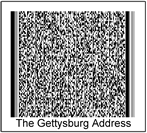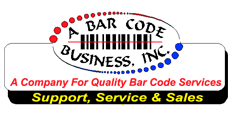Introduction To Bar Coding
Brief History of Bar Coding:
Bar Coding is an automatic identification (Auto ID) technology that streamlines identification and data collection. With some of its first concepts developed in the mid 1930s, bar coding has since grown into a $3.3-billion worldwide, multi-industry technology that is forecasted to grow annually by as much as 20% through the end of the century.
Bar coding’s early roots in the 1940s seriously expanded to the retail marketplace in the late 1960s, with efforts to develop a standard for automating supermarket point-of-sale. By 1972, RCA developed a bull’s-eye symbol and scanner that operated in a Kroger store in Cincinnati, Ohio. Revisions and developments gathered from this initial test site led to the development and adoption of the UPC (Universal Product Code) symbol as the industry standard for grocery stores in the United States on April 3, 1973.
The early industrial applications of bar coding can be traced back to the early 1960s, where Westinghouse Air Brake filed a patent describing a bar code attached to a railroad car. By 1974, 95% of all U.S. freight cars had been labeled with retroreflective bar code symbols before the poorly performing system was abandoned due to insufficient training, maintenance and equipment investments.
During the 1970s, bar coding became increasingly practical and economical with the advent of low- cost electronics (microprocessors) and lower cost lasers. While numerous companies devised their own bar code symbologies and scanning equipment, the stability of the UPC system gave rise to industrial acceptance and the need for standardization. In the early 1980s, standardization activities of bar code symbologies and specifications took place with Military Standard 11 89 for Code 39. Other standards such as ANSI Standard MHl 0.8M, UPC Shipping Container standards, and automotive Industry Action Group (AIAG) standards soon followed suit, as did specifications from other industries such as paper, aluminum, electronics, telecommunications, and furniture development.
The late 1980s brought achievements in other symbology developments, which reduced the space required by bar codes while increasing their data capacity. By the 1990s, multi-row, high capacity, two-dimensional symbologies such as PDF417 and Code One were developed.
The evolution of bar coding standards brought with it the need for greater precision, technical refinement and uniformity. Responding to this need, the trade organization of Automatic Identification Manufacturers (AIM) developed Uniform Symbol Specifications (USS) for numerous bar code symbologies which have standardized the technology throughout the world. Bar code technology is the cornerstone of the Auto ID industry, but it does not work alone. The combination of bar coding with the appropriate computer hardware, application software, training and utilization create the potential for improved performance, productivity and profitability in virtually any industry.
Benefits of Bar Coding
Bar codes offer the simplest, most accurate, cost-effective method of data entry and collection. Compared to manual entry methods which possess an error rate of one in every 300 characters entered bar coding is virtually error-free. With less than one error per one million characters entered, bar coding offers numerous advantages over traditional, manual methods of data entry.
Bar codes can be printed at a low cost with a wide variety of printing techniques. Symbols can be scaled to suit particular requirements, can be printed at very high speeds, and can be read by a variety of readily available reading/scanning equipment. Bar codes offer exceptional security, minimize errors and offer highly successful first-time read rates. Scanning a bar code brings speed and productivity improvements, and real-time data interchange (via radio frequency scanning equipment) allows timely information to be accessed almost instantly while the data is still current. Bar codes are frequently printed with human-readable text, which allows for simultaneous automatic and human decoding.
Additionally, reduced labor costs, improved organizational productivity and profitability can be realized with the implementation and use of a bar coding system. Any process or procedure that involves manual entry can be made faster and more accurate by using bar codes.
Summary:
- Accurate data collection
- Faster data entry
- Real-time collection and dissemination of data
- More effective use of human and physical resources Elimination of manual data entry/retrieval systems
Bar codes typically employ a parallel arrangement of varying-width bars and spaces, arranged in a particular pattern to incorporate data. Both the black bars and white spaces in bar code symbols are used to enter and decode data. While some bar codes use the bar height and/or diameter to incorporate data, linear symbologies are the most common form of bar codes in use today.

Linear bar code symbols use a single row of parallel bars and spaces to encode information.
The term “Symbology” is a set of rules describing how the data is incorporated into the various arrangements of bars. Symbology refers to the bar code language. Each language has different capabilities, rules and characteristics, much like human language. Scanners are typically programmed to decode one or more different symbologies, and communication cannot occur unless the reading and printing equipment use compatible symbologies (i.e., a scanner programmed to decode Code 39 will not be able to decode Code 128).
Bar code symbologies differ in the amount of data that can be encoded. Some symbologies (such as UPC) are fixed in length; other symbologies can encode truly variable data. Some bar code symbologies also contain various characteristics to minimize errors, such as self-checking characters, start and stop characters, check digits and error correction characters.
 UPC:
UPC:
- Incorporates numeric characters only
- 2 versions of Code:
- Version A – 12 digits
- Version E – 7 digits (also known as “zero suppressed version,” suited for use on small product packages)
- Check digit incorporated into code
- Allows bidirectional scanning
- Bar code size required (including quiet zone) for UPC Version A at 100% magnification is 1.5″ wide by 1″ high
- Two EAN (European Article Numbering) versions used in Europe
- Version EAN-13 – 13 digits
- Version EAN-8 – 8 digits
- Applications primarily include retail and packaging
- Quiet Zone is 10 times the x dimension or 1/4″ on each end of the barcode.
UPC symbols are decoded as a twelve-digit number, representing the following:
- Digit 1 = number system (as established by the Uniform Code Council (UCC).
- Digits 2-9 manufacturer’s identification (also includes digit one)
- Digits 7-11 unique product code identification (manufacturers often use SKUs for these digits)
- Digit 12 = check character (used for error detection)
- Zero suppressed UPCs decode as twelve-digit numbers, but only 7 digits appear in human-readable form
 Code 3 of 9 (Code 301):
Code 3 of 9 (Code 301):
- Incorporates alphanumeric characters (the first alphanumeric symbology ever developed)
- Code can be of variable length
- Allows for bidirectional scanning
- Use of full ASCII character set allowed a Check digit is optional
- Code density approximately 3 to 9.4 characters per inch
- Quiet zone is 1 0 times the width of the narrowest bar
- Applications include LOGMARS (Dept. of Defense), AIAG (automotive) and general industry
The Code 39 bar code is a variable length, bidirectional, discrete, self-checking, alphanumeric symbol. Its standard data character set contains 43 characters: 0-9; A-Z; -.$/+%, and space. An asterisk is used exclusively for both Start and Stop characters, and must be included in every symbol. Code 89’s flexibility to encode alpha and numeric characters has contributed to its widespread use.
 Code 128:
Code 128:
- Incorporates high-density, alphanumeric characters
- Code can be of variable length
- Allows bidirectional scanning
- Check digits included in every symbol
- Symbology incorporates three different character sets: A, B, and C
- Encodes the full 128 character ASCII set using the A, B, or C character sets
- Applications include general industrial, inventory control, retail container marking and retail distribution
Each Code 128 symbol contains data framed by a start symbol, check digit, and a stop symbol. The start pattern selects the initial character set (A, B, or C), and the data portion can be of arbitrary length. Any character on a CRT keyboard (including control characters) can be encoded, thus giving users more versatility than other industrial bar codes.
 Interleaved 2-of-5 (I2 of 5):
Interleaved 2-of-5 (I2 of 5):
- Incorporates high-density, numeric characters only
- Code is of variable length 001234567890
- Code consists of digit pairs, the first digit of each pair is encoded in the bars, the second in the spaces.
- (Number of encoded characters must be even; leading zeroes are added to odd-length data messages.
- Allows for bidirectional scanning. Quiet zone is 10 times the width of the narrow bar
- Applications include distribution, warehousing, product/container identification, general industry and automotive.
- Partial scans (i.e., scanning path does not include both quiet zones) have a high probability of decoding as valid but shorter information due to the simple nature of the code’s start and stop patterns.
- Best used in fixed-length applications due to partial scan problems
- Bearer Bars (horizontal bars across top and bottom of all bars in code) can help eliminate partial scan errors
- Highest density conventional bar code symbology available for numeric messages of less than 10 digits
I2-of-5 characters are interleaved together using the bars to represent data characters occupying the odd positions and spaces for the even positioning. Complete 12 of 5 symbols consist of the start code, the data characters, and the stop code, Check digit use is optional.
 Codabar:Incorporates numeric numbers, the $ + – characters, and Start/Stop codes which are lower case a, b, c or d
Codabar:Incorporates numeric numbers, the $ + – characters, and Start/Stop codes which are lower case a, b, c or d
- Allows bidirectional scanning
- No check digit
- Applications include inventory control, libraries, blood banks, photofinishing and certain air parcel express applications
- Quiet zone is 10 times the width of the narrow bar
Codabar is a discrete, self-checking code, whose characters are constructed from four bars and three intervening spaces – a particularly large number of printed element widths. A complete Codabar symbol begins with one of the Stop/Start characters. Since any of the Stop/Start characters may be used on either end of the symbol, four different types of information may be encoded in these characters.
 PDF417 (The Gettysburg Address):
PDF417 (The Gettysburg Address):
- Multi-row symbology
- High data capacity – acts as a portable data file to provide low-cost access to large amounts of information without the need to link to an external database
- Applications include hospitals/patient identification, drivers’ licenses, materials handling, bills of lading and freight tracking
- Quiet zone required above and below the symbol, as well as at the two ends
- Optional error correction characters available to ensure proper decoding, even if parts of the symbol are damaged
PDF417, introduced by Symbol Technologies in 1990, is a multi-row, continuous, variable length symbology which has high data capacity, Every symbol has between 3 and 90 rows” each row contains a start pattern, a left row indicator, a right row indicator and a stop pattern. The character sets used by PDF417 include all 128 ASCII and all 128 extended ASCII characters, 8-bit binary data, and up to 811,800 different interpretations, with a maximum data capacity of 1850 text characters.
